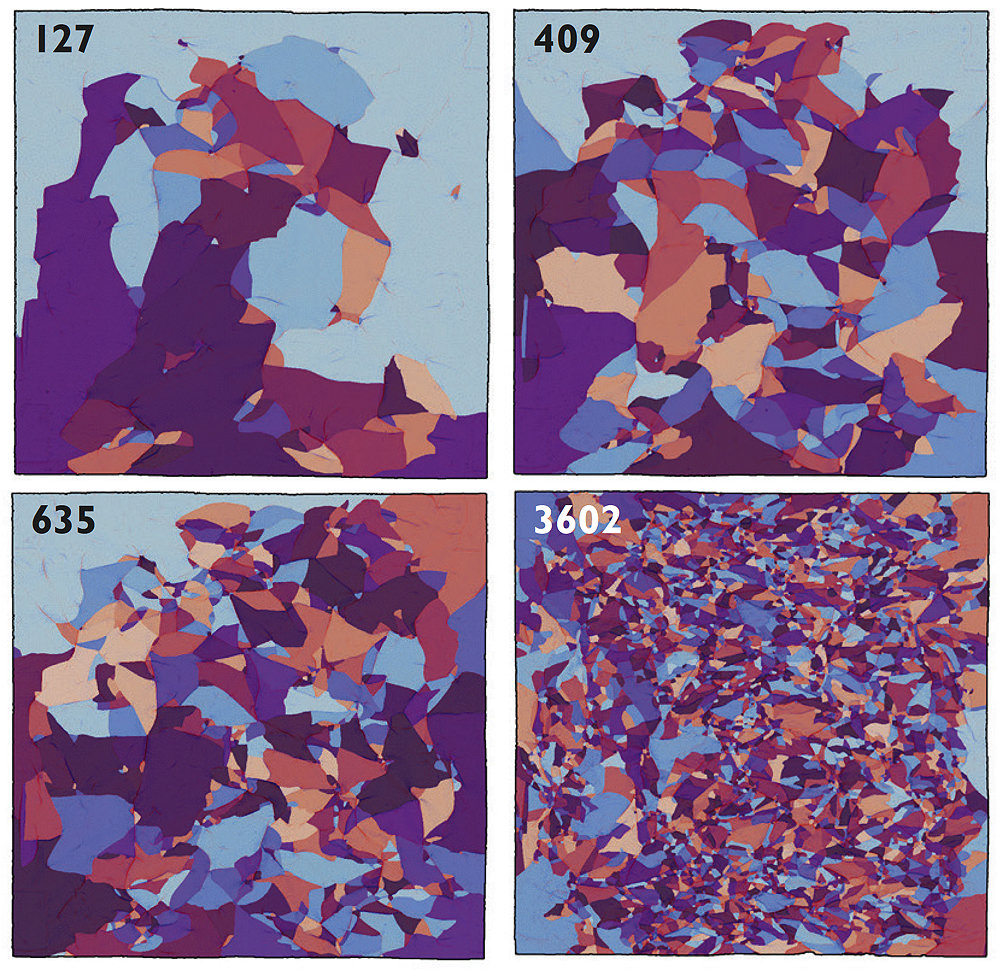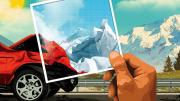You probably crumple up paper without ever considering that such a routine act could be of scientific interest. But researchers at Harvard—including Loeb associate professor of engineering and applied sciences Christopher Rycroft and his doctoral student, Jovana Andrejevic—have spent years studying this very process. They see direct parallels between paper folding and the folding of the earth’s crust, which thrusts mountain ranges to the sky and makes the earth tremble in ways no one would dismiss as trivial.
In 2018, Rycroft and Andrejevic published an article with Harvard physicist Shmuel Rubinstein and his former student Omer Gottesman, Ph.D. ’20, in which they described a novel experiment: they rolled up a sheet of Mylar™, a thin plastic more durable than paper, placed it in an upright cylinder, and then crumpled it, applying uniform force to press it down to a fixed point. Next, they unraveled the sheet, measured the combined length of all its creases, and repeated the process as many as 24 times.
After subjecting multiple sheets to the same treatment, they found no consistent pattern in the formation of creases from one sheet to another, but did discover one thing common to all of them: crease length grew logarithmically, which is to say more slowly with each successive crumple. Each time they crumpled the Mylar™, they got fewer new creases and smaller gains in crease length. A typical 10-by-10 centimeter sheet might have a crease-length total of 0.8 meters after one crumple, of 1.4 meters after two, 1.9 meters after three, and 6.9 meters after 24 crumples. By comparison, linear growth, in which each crumple leads to the same increase in crease length, would be much faster, and exponential growth faster still.
That study raised a question explored in a 2021 paper by Andrejevic, Rubinstein, Rycroft, and former Harvard doctoral student Lisa Lee: What underlying physical principle could account for such a robust and reproducible effect? “This paper was about trying to figure out the why of logarithmic growth,” Andrejevic explains. “Initially we focused on the creases, which is what we’d been looking at in 2018. But we soon realized that we were overlooking the facets—the flat, empty spaces bounded by creases that comprise essentially the entire surface area of the sheets. That gave us a new perspective on the problem, which turned out to be the key.”
The total facet area does not change with repeated crumplings, but the number of facets grows as new creases form and individual facets become ever smaller. The researchers wanted to figure out exactly how the number of facets and their average size change over time. Their automated methods for doing this (based on so-called image segmentation software) weren’t wholly reliable, mainly because facet boundaries (i.e., creases) can be difficult to discern, so Andrejevic took matters into her own hands, quite literally. Drawing on her arts background, she hand-traced all the facets—21,110 in total, from 24 separate Mylar™ sheets—labors that have since been characterized as “herculean.”

Hand-tracing the increasing number of facets that resulted each time a sheet was crumpled allowed researchers to quantify that growth mathematically.
Courtesy of Jovana Andrejevic/Harvard SEAS
But it was worth the painstaking effort. When she and her colleagues drew graphs showing the number of facets of a given size, the curves in their plots had a characteristic shape. “They follow a specific mathematical form that is prescribed by fragmentation theory,” Andrejevic says: the same theory that explains how mountains or boulders break down into rocks, pebbles, sand, and dust.
The match with fragmentation theory was “shockingly good,” according to Rycroft, and their findings cast that theory in a new light. “In this case, the things that are fragmenting are not solid objects like stones or pebbles, but are instead more intangible”—areas on a piece of paper delineated by folds.
Even though he and Andrejevic are theoretically inclined, their work could have practical consequences. “What’s really motivating us,” Andrejevic says, “is the bigger picture. Crumpling is a widespread phenomenon that occurs in many materials and is also the mechanism by which many materials fail”—sometimes by design. “Crumple zones” in cars, for instance, are engineered so that energy from an impact is directed to, and absorbed in, the front and rear of the vehicle’s body, in order to protect the central portions where people sit. In another application, crumpled sheets of graphene are being investigated for use as battery electrodes, because of their greater structural stability than flat sheets and also because they offer more surface area for chemical reactions than their flat counterparts (which tend to cling together).
Looking more broadly, Rycroft asks, “How does damage accumulate under repeated loading, such as with an airplane wing that oscillates thousands of times over its lifetime? There are lots of types of failure modes that happen along thin lines—earthquakes being notable examples. Ideas from our paper can contribute to understanding situations like that.”
Although their experiments provide a good description of the crease patterns that emerge during crumpling, Rycroft maintains, “We don’t understand the mechanics of how this happens.” One of the challenges is that when the sheets are being compressed in the cylinders, it is hard to observe what is going on, let alone make good measurements. To address this problem, his team is refining their simulations to provide “a new window” into what is happening. “There’s a lot more to be discovered here,” he says. A crumpled piece of paper holds more mysteries than most people would imagine.









